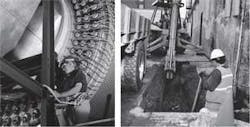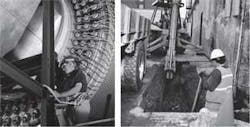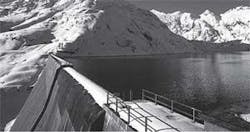Innovative IT Solutions Help Utilities Overcome Global Challenges
How water and wastewater utilities can improve efficiency, customer service, conservation with cutting–edge metering technologies and data, asset and enterprise management software.
By Henry Bailey
Water, water everywhere, but not a drop to drink” was penned by 19th century British poet Samuel Taylor Coleridge. But as water utilities face a new set of challenges in the 21st century, it seems more profound today as availability of freshwater declines, global populations and demands grow, and millions of tons of wastewater are dumped daily into the world’s waterways.
The new millennium brought new challenges to water and wastewater utilities in every corner of the world, among them a rising tide of capital costs for aging water infrastructure renovations and new development, security upgrades, advanced water treatment methods, an increasing flood of government regulations over security requirements and drinking water standards, and the challenges of this highly regulated and fragmented industry being drained by consolidation.
Whether in Rome, Italy, or Rome, New York, at the top of every water and wastewater utility executive’s mind is how can they achieve operational excellence with efficient meter–to–cash management, supply operations, and customer service as well as comply with government regulations, unrelenting pressure to reduce costs, and the intensifying push to go “greener” and conserve this life–sustaining commodity.
Transforming Business Models
To address these challenges, water utilities must implement innovative IT solutions and best practices that can master the business processes so vital to the utility: asset management, knowledge management, and resource management. This adoption of new business models can help them adapt to the latest challenges and transform their organizations into the water utilities of the future – all while remaining focused on its primary goal: to provide more competitive service for residential, commercial and industrial customers. But to affect this transformation, the utility must embrace enterprise–wide systems that can connect previously disparate parts of the organization, unifying isolated silos of data and processes to emerge as a more adaptable organization.
First, the utility, which most likely has an aging infrastructure that developed over decades and became entrenched in the municipality’s system, must look beyond standard practices and develop new business models that promise results and, once found, determine what strategies and practices are right for that particular utility. Can it thrive amid regulatory and public scrutiny? Can it balance reliability of supply, operational excellence and career prospects? What are the best cutting–edge solutions for facilitating strategies?
Among emerging technologies, for example, are:
- Service–oriented architecture which lets companies deploy best practice templates and create new applications on top of existing ones, increasing the value of current systems.
- Mobile and radio frequency identification (RFID) and geographic information systems (GIS) deliver up–to–the–minute visibility into the placement, use, and condition of assets in the field.
- Demand responses such as “smart” or two–way metering bring innovation billing scenarios to residential water customers and allow better risk management.
- Self–service technology helps customer gain more confidence in using the Web and allow utilities to transfer higher–level services to both the Internet and to automated voice services.
- Collaboration technology greatly improves the handling of routine jobs and self–services reduce administration burdens and electronic forms replace paper–based ones.
Efficiency, Revenue Benefits
Reengineering aging infrastructures to take advantage of new and innovative IT solutions, though, won’t happen overnight. It requires commitment from the highest level, but the good news is it can happen by implementing the right IT solutions that can help master business processes along the entire asset–centric, customer–centric value chain.
Once mastered, the benefits in efficiency and revenues for the utility will include:
- Optimized meter–to–cash processes that provide end–to–end management of service, billing, and financial processes;
- Increased customer satisfaction and call center efficiency using an integrated customer service collaboration solution that automates standard services and provides fast access and single view into all data and work history related to customers, including water consumption, quality, service disruption, speed of call resolution, and volume of calls;
- Improved efficiencies in supply operations by providing a utility–wide supply operations solution connecting project and work management capabilities and best–of–breed scheduling, outage management, and construction planning – all integrated with core back–office functions and information on customers, meters, hydrants, financials and the workforce;
- Integrated financial information using standardized processes; providing visibility on capital, operational and third–party expenditures; monitoring project costs and regulatory risks; and integrating business performance information with management processes;
- Better managed investment opportunities and risk through the establishment of strategic enterprise management techniques;
- Optimized procurement processes and material inventory by enabling collaboration and contracting of operational management services with suppliers, contractors, and partners, as well as streamlining corporate–wide buying processes; and
- Streamlined and simplified workforce processes through integrated employee transaction management, workforce deployment based on skills and availability, and innovative employee life–cycle management that aligns employee talents with corporate goals. This will help revitalize the knowledge base being lost as older workers retire and also, with mobile “smart” devices, free resources to do other jobs.
For example, water utilities already shifted by these IT solutions to new business models where better work planning and field dispatching, asset optimization, and operational efficiency have been achieved include:
- Vitens NV – Established in the Netherlands after the merger of three Dutch water companies, it integrated disparate IT systems and reduced dependency on inefficient, error–prone paper–based processes. This system also enables mobile support for the company’s service engineers, who can now view digitized piping systems drawings in the field and complete administrative work remotely.
- Marin Municipal Water District (MMWD) – In Marin County, California, USA, it now links utility billing and the general ledger, human resources and payroll, and warehousing and asset tracking. It also links with a GIS, with which work crews use GIS–generated maps to identify repair sites and detail equipment configurations. With better data, Marin reduced the dollar volume of inventory by 25% and the amount retained in its capital projects budget by 45%.
- Pittsburgh Water and Sewer Authority (PSWA) – This Pennsylvania, USA, utility wanted to replace outgrown hardware and software, improve integration, and maintain a high level of customer service during integration. By installing an integrated enterprise resource planning (ERP) solution, it can now bill 30,000 more customers per month with no increase in staff.
- WaterOne – This quasi–municipal agency in Johnson County, Kansas, USA, improved its overall operations with the integration of enterprise accounting, human resources, procurement, customer information, maintenance and work order, and permits management. Employees now have more timely and accessible information through deployment of analytics and dashboards.
So, from new market models to smart meters and intelligent–grid operations, technology will continue to enable water and waste treatment utilities to evaluate data, perform procurement and trading functions, reconcile and settle billing and transactional activities. Use of these kinds of innovative information technologies will help water utilities provide a higher level of service to their customers, increase agility, and improve the bottom line – now and well into the future.
Author’s Note:
Henry Bailey is vice president for the Industry Solutions Group – Service Industries at SAP Americas, based in Newtown Square, Pennsylvania, USA. With 15 years experience, he’s received several U.S. Patents on software processes and components for utility systems. At SAP, he works on customer and asset management solutions, mobility solutions, data warehouse products and optimization systems that leverage technology partners. Contact: www.sap.com




